Physicochemical Properties of Cellulose Ethers
Abstract
:1. Introduction
2. Materials and Methods
2.1. Tested Ingredients
2.2. Preparation of Solutions
2.3. Evaluation of Solution Clarity
2.4. Rheological Studies of Solution Viscosity
2.5. LAOS Tests to Evaluate Texture
2.6. Friction Coefficient Measurements
2.7. DVS Measurements
2.8. Determination of Surface Tension
2.9. Thermal Analysis
3. Results and Discussion
3.1. Solution Clarity, Viscosity, Salt Tolerance, and Surfactant Compatibility
3.2. Textural Properties of the Cellulose Ether Solutions
3.3. Determination of Friction Coefficient
3.4. Vapor Sorption Properties
3.5. Surface Tension Measurements
3.6. Thermal Analysis
4. Conclusions
Author Contributions
Funding
Acknowledgments
Conflicts of Interest
References
- Wertz, J.; Bédué, O.; Mercier, J. Cellulose Science and Technology; EPFL Press: Lausanne, Switzerland, 2010. [Google Scholar]
- Kamide, K. Cellulose and Cellulose Derivatives: Molecular Characterization and its Applications; Elsevier: Amsterdam, The Netherlands, 2005. [Google Scholar]
- Kongruang, S.; Han, M.; Breton, C.G.; Penner, M. Quantitative analysis of cellulose-reducing ends. Appl. Biochem. Biotechnol. 2004, 113, 213–231. [Google Scholar] [CrossRef]
- Wüstenberg, T. Cellulose. In Cellulose and Cellulose Derivatives in the Food Industry: Fundamentals and Applications; Wiley-VCH: Weinheim, Germany, 2015; pp. 91–141. [Google Scholar]
- Coffey, D.; Bell, D. Cellulose and Cellulose Derivatives. In Food Polysaccharides and Their Applications; Stephen, A., Ed.; Marcel Dekker: New York, NY, USA, 1995; pp. 123–153. [Google Scholar]
- Arca, H.; Mosquera-Giraldo, L.; Bi, V.; Xu, D.; Taylor, L.; Edgar, K. Pharmaceutical applications of cellulose ethers and cellulose ether esters. Biomacromolecules 2018, 19, 2351–2376. [Google Scholar] [CrossRef] [PubMed]
- Croll, S.; Kleinlein, R. Influence of Cellulose Ethers on Coating Performance. In Water-Soluble Polymers; Glass, J., Ed.; American Chemical Society: Washington, DC, USA, 1986; pp. 333–350. [Google Scholar]
- Liu, K.; Du, H.; Zheng, T.; Liu, H.; Zhang, M.; Zhang, R.; Li, H.; Xie, H.; Zhang, X.; Ma, M.; et al. Recent advances in cellulose and its derivatives for oilfield applications. Carbohydr. Polym. 2021, 259, 117740. [Google Scholar] [CrossRef] [PubMed]
- Brady, J.; Dürig, T.; Lee, P.; Li, J. Polymer properties and characterization. In Developing Solid Oral Dosage Forms; Qiu, Y., Ed.; Academic Press: London, UK, 2016; pp. 181–223. [Google Scholar]
- Final report on the safety assessment of hydroxyethylcellulose, hydroxypropylcellulose, methylcellulose, hydroxypropylmethylcellulose, and cellulose gum. J. Am. Coll. Toxicol. 1986, 5, 1–59. [CrossRef]
- Desmarais, A.; Wint, R. Hydroxyalkyl and ethyl ethers of cellulose. In Industrial Gums: Polysaccharides and Their Derivatives; Whistler, R., BeMiller, J., Eds.; Academic Press: San Diego, CA, USA, 1993; pp. 505–535. [Google Scholar]
- Klug, E. Some properties of water-soluble hydroxyalkyl celluloses and their derivatives. J. Poly. Sci. Part C 1971, 36, 491–508. [Google Scholar] [CrossRef]
- Lopez, C.; Colby, R.; Graham, P.; Cabral, J. Viscosity and scaling of semiflexible polyelectrolyte NaCMC in aqueous salt solutions. Macromolecules 2016, 50, 332–338. [Google Scholar] [CrossRef]
- DeButts, E.; Hudy, J.; Elliot, J. Rheology of sodium carboxymethylcellulose solutions. Ind. Eng. Chem. 1957, 49, 94–98. [Google Scholar] [CrossRef]
- Benyounes, K.; Remli, S.; Benmounah, A. Rheological behavior of hydroxyethylcellulose (HEC) solutions. J. Phys. Conf. Ser. 2018, 1045, 012008. [Google Scholar] [CrossRef]
- Prodduturi, S.; Manek, R.; Kolling, W.; Stodghill, S.; Repka, M. Water vapor sorption of hot-melt extruded hydroxypropyl cellulose films: Effect on physico-mechanical properties, release characteristics, and stability. J. Pharm. Sci. 2004, 93, 3047–3056. [Google Scholar] [CrossRef]
- Blažková, A.; Hrivíková, J.; Lapčík, L. Viscosity properties of aqueous solutions of hydroxethylcellulose. Chem. Papers 1990, 44, 289–301. [Google Scholar]
- Kwiatkowski, A.; Sharma, H.; Molchanov, V.; Orekhov, A.; Vasiliev, A.; Dormidontova, E.; Philippova, O. Wormlike surfactant micelles with embedded polymer chains. Macromolecules 2017, 50, 7299–7308. [Google Scholar] [CrossRef]
- Ozkan, S.; Alonso, C.; McMullen, R. Rheological fingerprinting as an effective tool to guide development of personal care formulations. Int. J. Cosmet. Sci. 2020, 42, 536–547. [Google Scholar] [CrossRef] [PubMed]
- Ozkan, S.; Gillece, T.; Senak, L.; Moore, D. Characterization of yield stress and slip behaviour of skin/hair care gels using steady flow and LAOS measurements and their correlation with sensorial attributes. Int. J. Cosmet. Sci. 2012, 34, 193–201. [Google Scholar] [CrossRef] [PubMed]
- Gillece, T.; McMullen, R.; Fares, H.; Senak, L.; Ozkan, S.; Foltis, L. Probing the textures of composite skin care formulations using large amplitude oscillatory shear. J. Cosmet. Sci. 2016, 67, 121–159. [Google Scholar] [PubMed]
- Sun, W.; Yang, Y.; Wang, T.; Liu, X.; Wang, C.; Tong, Z. Large amplitude oscillatory shear rheology for nonlinear viscoelasticity in hectorite suspensions containing poly(ethylene glycol). Polymer 2011, 52, 1402–1409. [Google Scholar] [CrossRef]
- Yu, K.; Hodges, C.; Biggs, S.; Cayre, O.; Harbottle, D. Polymer molecular weight dependence on lubricating particle-particle interactions. Ind. Eng. Chem. Res. 2018, 57, 2131–2138. [Google Scholar] [CrossRef]
- Matjukhov, A.; Mironov, B.; Anisimov, I. The influence of molecular mass distribution, size, and elasticity of macromolecules on friction reduction effect. In The Influence of Polymer Additives on Velocity and Temperature Fields; Gampert, B., Ed.; Springer: Essen, Germany, 1985; pp. 107–118. [Google Scholar]
- Majewicz, T.; Erazo-Majewicz, P.; Podlas, T. Cellulose ethers. In Encyclopedia of Polymer Science and Technology; Mark, H., Ed.; John Wiley & Sons: Hoboken, NJ, USA, 2002; pp. 507–532. [Google Scholar]
- Riedl, Z.; Szklenárik, G.; Zelkó, R.; Marton, S.; Rácz, I. The effect of temperature and polymer concentration on dynamic surface tension and wetting ability of hydroxypropylmethylcellulose solutions. Drug. Dev. Ind. Pharm. 2000, 26, 1321–1323. [Google Scholar] [CrossRef] [PubMed]
- Formulating Elegant Liquid and Semisolid Drug Products: Natrosol 250 Hydroxyethylcellulose (HEC); PHA18-101; Ashland LLC: Wilmington, DE, USA, 2018.
- Um, S.; Poptoshev, E.; Pugh, R. Aqueous solutions of ethyl (hydroxyethyl) cellulose and hydrophobic modified ethyl (hydroxethyl) cellulose polymer: Dynamic surface tension measurements. J. Colloid Interface Sci. 1997, 193, 41–49. [Google Scholar] [CrossRef]
- Nasatto, P.; Pignon, F.; Silveira, J.; Duarte, M.; Noseda, M.; Rinaudo, M. Interfacial properties of methylcelluloses: The influence of molar mass. Polymers 2014, 6, 2961–2973. [Google Scholar] [CrossRef] [Green Version]
- Newman, A.; Zografi, G. Commentary: Considerations in the measurement of glass transition temperatures of pharmaceutical amorphous solids. AAPS PharmSciTech 2020, 21, 26. [Google Scholar] [CrossRef] [Green Version]
- Rafferty, D.; Zellia, J.; Hasman, D.; Mullay, J. Polymer composite principles applied to hair styling gels. J. Cosmet. Sci. 2008, 59, 497–508. [Google Scholar] [CrossRef]
- Kubát, J.; Pattyranie, C. Transitions in cellulose in the vicinity of −30 °C. Nature 1967, 215, 390–391. [Google Scholar] [CrossRef]
- Salmén, N.; Back, E. The influence of water on the glass phase transition temperature of cellulose. Tappi 1977, 60, 137–140. [Google Scholar]
- Szcześniak, L.; Rachocki, A.; Tritt-Goc, J. Glass transition temperature and thermal decomposition of cellulose powder. Cellulose 2008, 15, 445–451. [Google Scholar] [CrossRef]
- Hancock, B.; Zografi, G. The relationship between the glass transition temperature and the water content of amorphous pharmaceutical solids. Pharm. Res. 1994, 11, 451. [Google Scholar] [CrossRef]
- ASTM E2550-21; Standard Test Method for Thermal Stability by Thermogravimetry. ASTM International: West Conshohocken, PA, USA, 2021.
- Rials, T.; Glasser, W. Thermal and dynamic mechanical properties of hydroxypropyl cellulose films. J. Appl. Polym. Sci. 1988, 36, 749–758. [Google Scholar] [CrossRef]


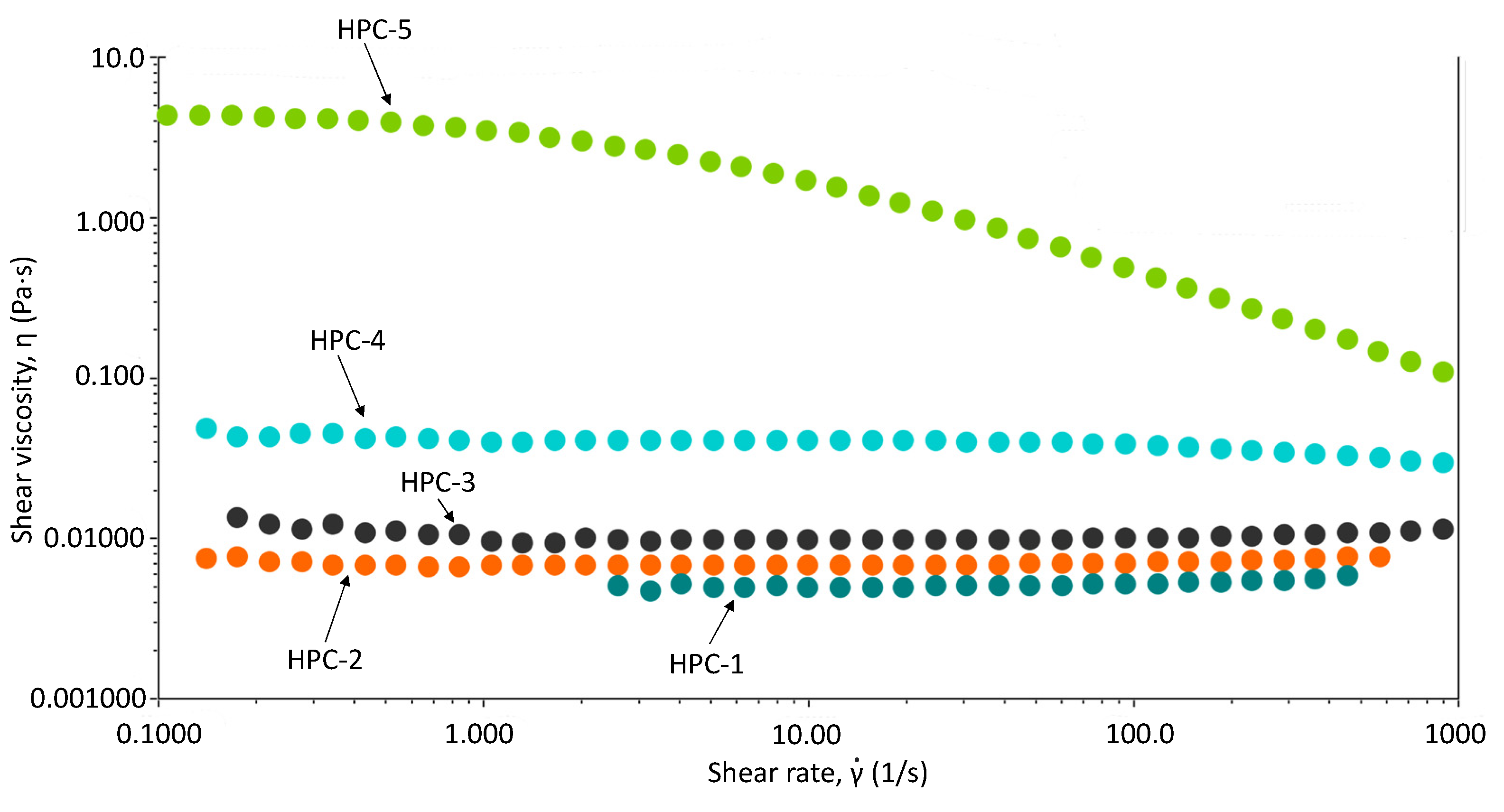
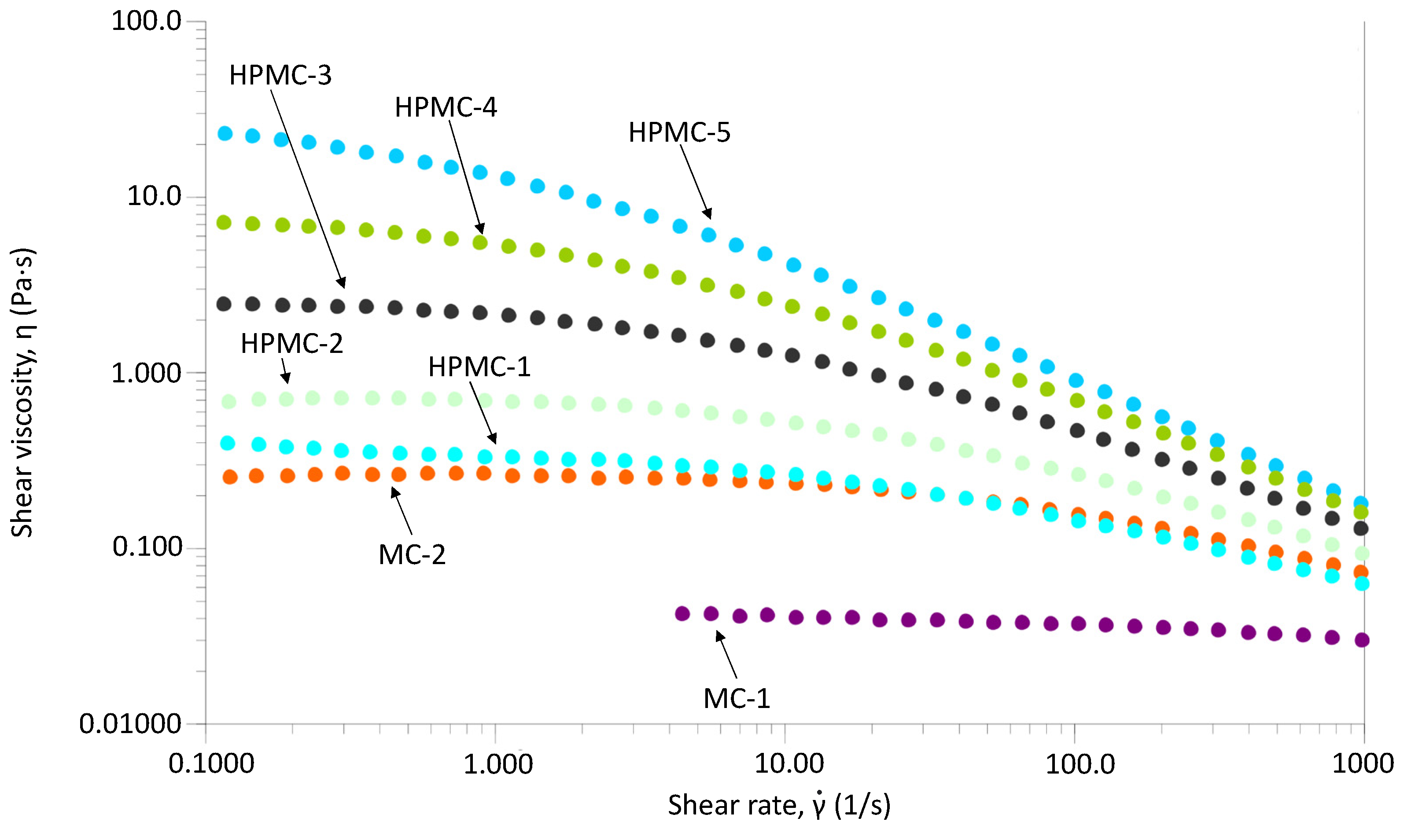
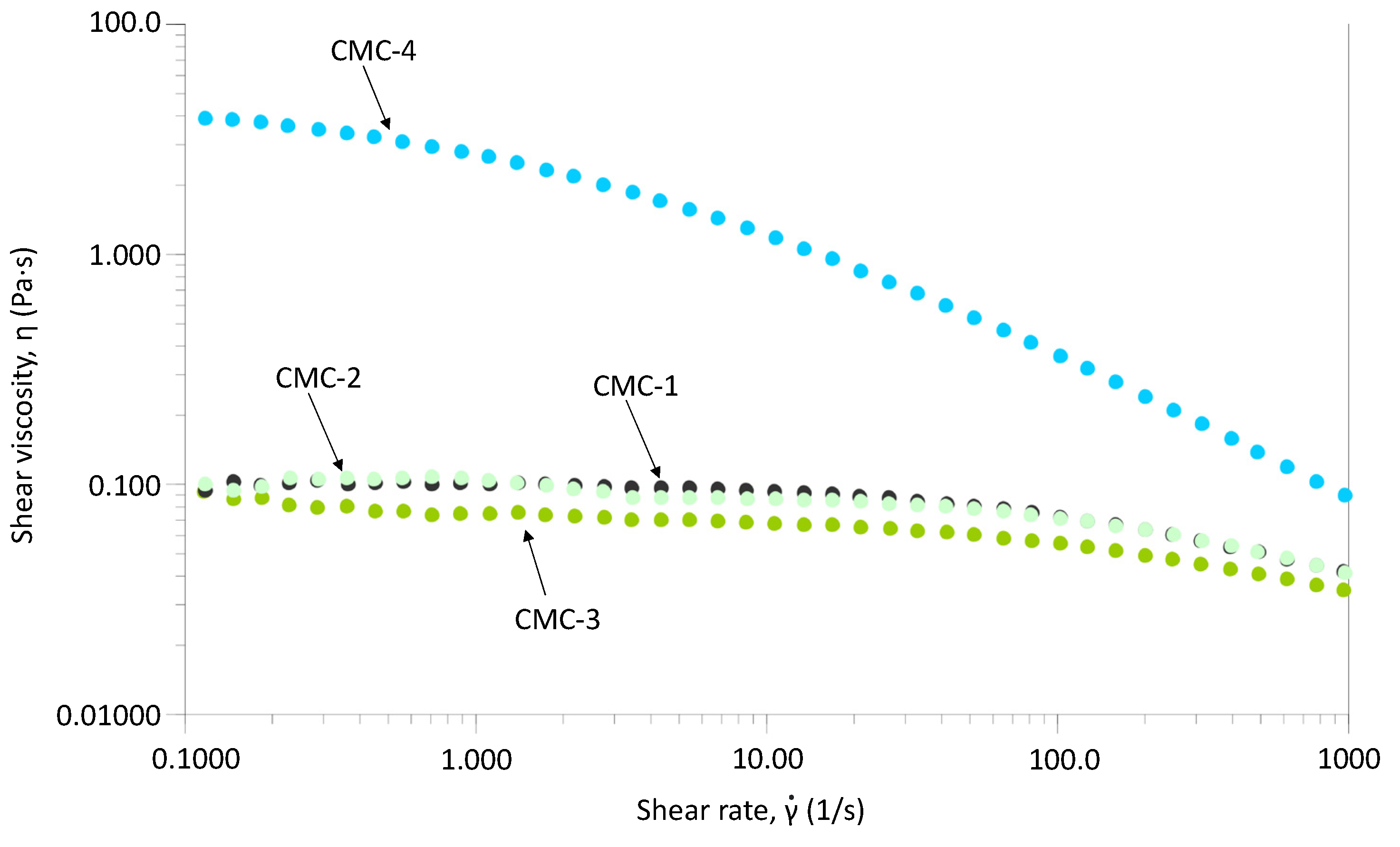
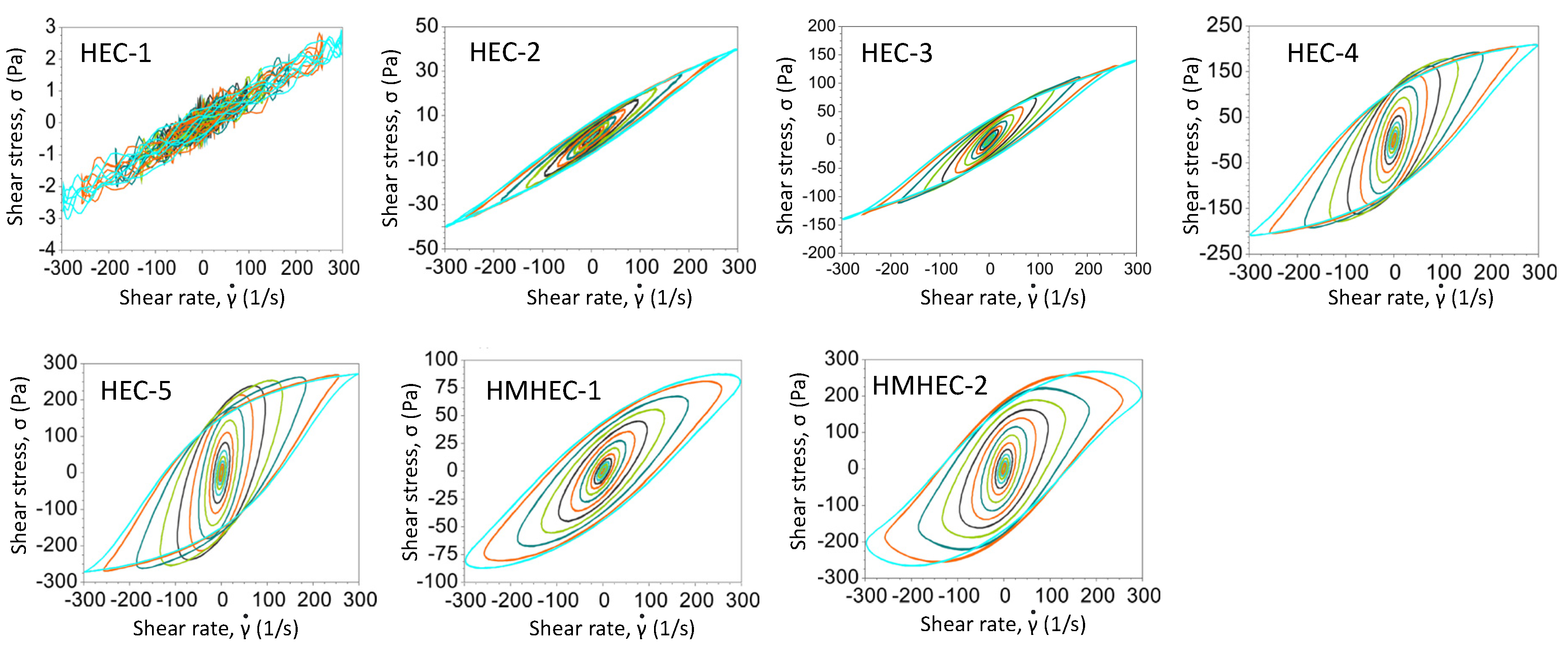
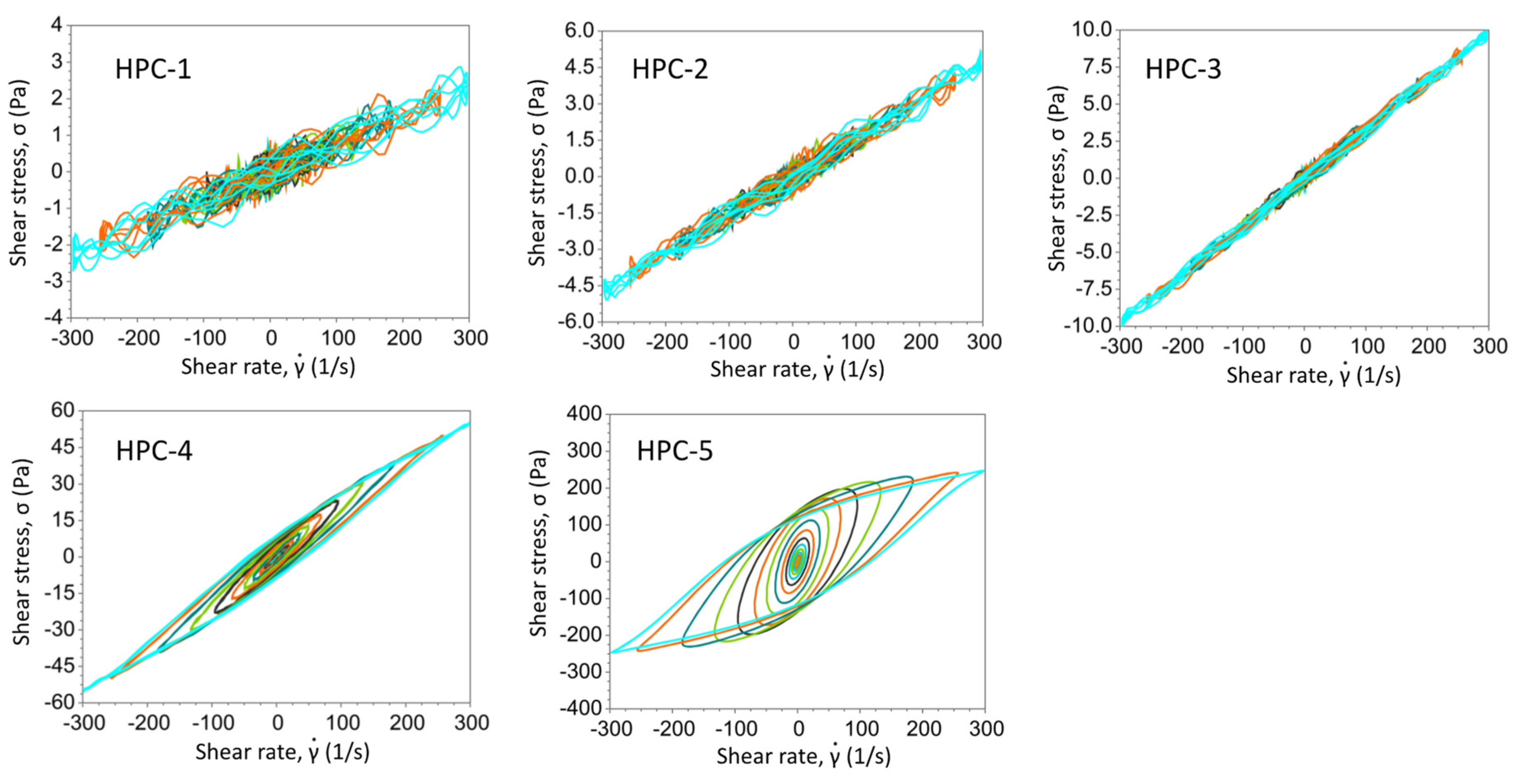
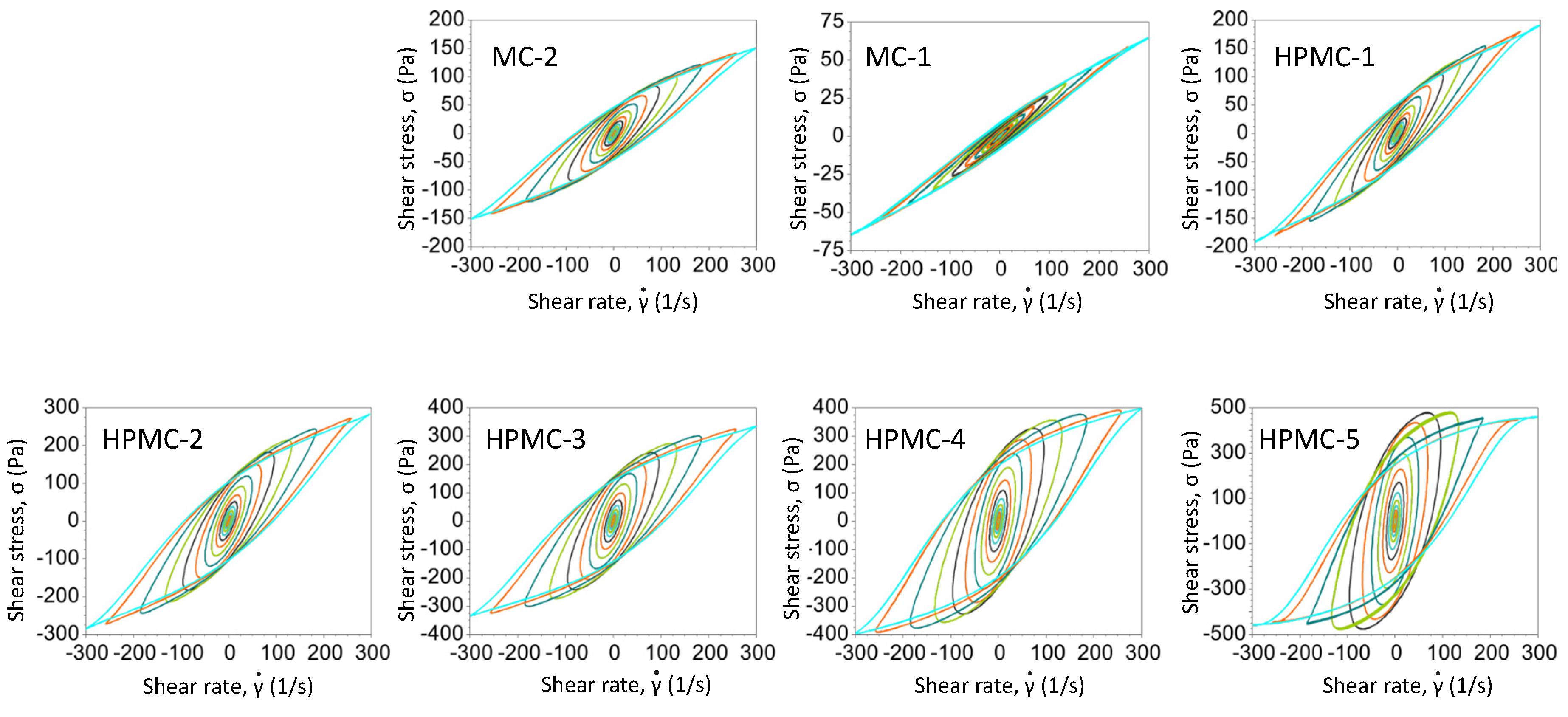
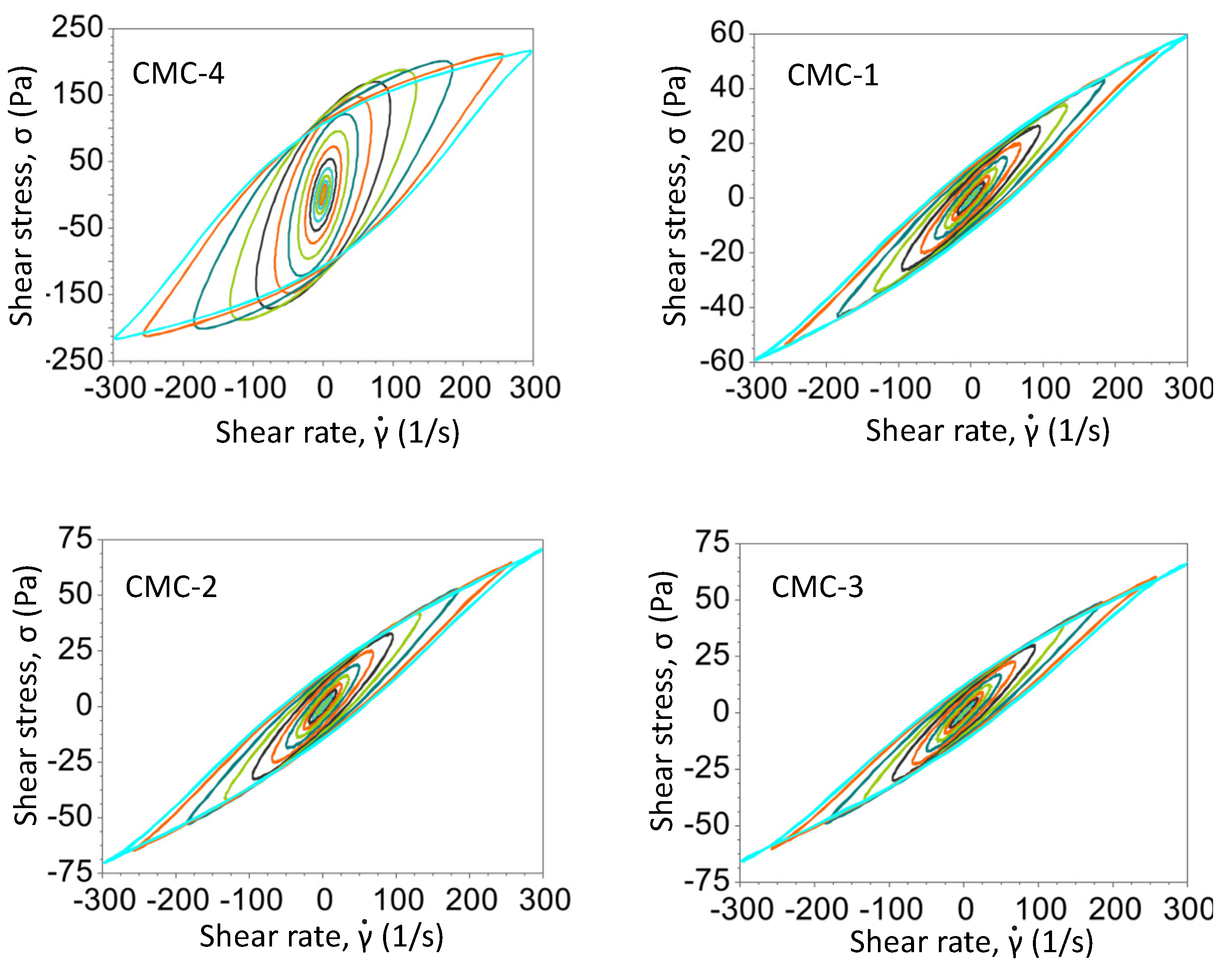
| Type of Cellulose Ether | Abbreviation in This Article | Approximate Molecular Weight (Mw, Daltons) | Approximate DS/MS |
|---|---|---|---|
| HEC | HEC-1 | 90,000 | 2.6 MS |
| HEC | HEC-2 | 300,000 | 2.6 MS |
| HEC | HEC-3 | 720,000 | 2.6 MS |
| HEC | HEC-4 | 1,000,000 | 2.6 MS |
| HEC | HEC-5 | 1,300,000 | 2.6 MS |
| HMHEC | HMHEC-1 | 350,000 | 0.005 HM DS |
| HMHEC | HMHEC-2 | 550,000 | 0.005 HM DS |
| HPC | HPC-1 | 80,000 | 4.0 MS |
| HPC | HPC-2 | 95,000 | 4.0 MS |
| HPC | HPC-3 | 370,000 | 4.0 MS |
| HPC | HPC-4 | 850,000 | 4.0 MS |
| HPC | HPC-5 | 1,150,000 | 4.0 MS |
| HPMC | HPMC-1 | 400,000 | 1.5 Me DS 0.3 HP MS |
| HPMC | HPMC-2 | 575,000 | 1.5 Me DS 0.3 HP MS |
| HPMC | HPMC-3 | 675,000 | 1.5 Me DS 0.3 HP MS |
| HPMC | HPMC-4 | 1,000,000 | 1.5 Me DS 0.3 HP MS |
| HPMC | HPMC-5 | 1,200,000 | 1.5 Me DS 0.3 HP MS |
| MC | MC-1 | 140,000 | 1.8 DS |
| MC | MC-2 | 370,000 | 1.8 DS |
| CMC | CMC-1 | 250,000 | 0.7 DS |
| CMC | CMC-2 | 250,000 | 0.9 DS |
| CMC | CMC-3 | 250,000 | 1.2 DS |
| CMC | CMC-4 | 725,000 | 0.7 DS |
| Cellulose Ether | Salt/No Salt (0.1 s−1) | Salt/No Salt (1000 s−1) |
|---|---|---|
| HEC-1 | 1.03 | 1.03 |
| HEC-2 | 1.11 | 1.11 |
| HEC-3 | 1.63 | 1.43 |
| HEC-4 | 1.02 | 1.00 |
| HEC-5 | 1.11 | 1.04 |
| HMHEC-1 | 0.99 | 1.16 |
| HMHEC-2 | 0.87 | 0.99 |
| HPC-1 | 0.96 | 0.96 |
| HPC-2 | 0.96 | 0.96 |
| HPC-3 | 1.10 | 1.07 |
| HPC-4 | 1.13 | 1.13 |
| HPC-5 | 0.53 | 0.78 |
| HPMC-1 | 0.95 | 1.00 |
| HPMC-2 | 1.05 | 1.07 |
| HPMC-3 | 0.97 | 0.99 |
| HPMC-4 | 0.81 | 0.93 |
| HPMC-5 | 0.78 | 0.97 |
| MC-1 | 0.85 | 1.03 |
| MC-2 | 1.05 | 1.08 |
| CMC-1 | 0.71 | 0.74 |
| CMC-2 | 0.64 | 0.71 |
| CMC-3 | 0.45 | 0.60 |
| CMC-4 | 0.80 | 0.93 |
| Cellulose Ether | SLES/No SLES (0.1 s−1) | SLES/No SLES (1000 s−1) |
|---|---|---|
| HEC-1 | 1.35 | 1.35 |
| HEC-2 | 1.44 | 1.33 |
| HEC-3 | 0.67 | 1.04 |
| HEC-4 | 1.29 | 1.07 |
| HEC-5 | 1.16 | 1.02 |
| HMHEC-1 | 0.32 | 1.16 |
| HMHEC-2 | 0.04 | 1.09 |
| HPC-1 | 0.96 | 0.96 |
| HPC-2 | 0.84 | 0.84 |
| HPC-3 | 0.28 | 0.38 |
| HPC-4 | 0.70 | 0.70 |
| HPC-5 | 0.01 | 0.35 |
| HPMC-1 | 0.53 | 0.96 |
| HPMC-2 | 0.46 | 0.98 |
| HPMC-3 | 0.29 | 0.85 |
| HPMC-4 | 0.34 | 0.87 |
| HPMC-5 | 0.48 | 1.09 |
| MC-1 | 0.85 | 1.14 |
| MC-2 | 0.32 | 0.87 |
| CMC-1 | 1.03 | 0.88 |
| CMC-2 | 0.88 | 0.88 |
| CMC-3 | 0.66 | 0.80 |
| CMC-4 | 1.21 | 1.05 |
| Cellulose Ether | Static Friction Coefficient | Kinetic Friction Coefficient |
|---|---|---|
| HEC-1 | 0.64 ± 0.23 | 0.72 ± 0.04 |
| HEC-2 | 0.58 ± 0.14 | 0.60 ± 0.05 |
| HEC-4 | 0.22 ± 0.18 | 0.24 ± 0.11 |
| HEC-5 | 0.10 ± 0.06 | 0.13 ± 0.04 |
| HMHEC-1 | 0.12 ± 0.07 | 0.15 ± 0.02 |
| HMHEC-2 | 0.03 ± 0.01 | 0.12 ± 0.02 |
| HPMC-1 | 0.52 ± 0.26 | 0.81 ± 0.18 |
| HPMC-2 | 0.30 ± 0.22 | 0.47 ± 0.21 |
| HPMC-3 | 0.25 ± 0.19 | 0.38 ± 0.19 |
| HPMC-4 | 0.20 ± 0.25 | 0.22 ± 0.11 |
| HPMC-5 | 0.04 ± 0.03 | 0.12 ± 0.02 |
| MC-1 | 0.69 ± 0.25 | 0.91 ± 0.10 |
| MC-2 | 0.41 ± 0.26 | 0.65 ± 0.13 |
| CMC-1 | 0.64 ± 0.19 | 0.82 ± 0.09 |
| CMC-2 | 0.55 ± 0.23 | 0.70 ± 0.05 |
| CMC-3 | 0.58 ± 0.20 | 0.71 ± 0.06 |
| CMC-4 | 0.14 ± 0.12 | 0.23 ± 0.15 |
| Cellulose Ether | % Moisture Content |
|---|---|
| HEC-1 | 52.42 ± 0.13 |
| HEC-2 | 52.09 ± 0.24 |
| HEC-3 | 51.00 ± 0.17 |
| HEC-4 | 52.07 ± 0.42 |
| HEC-5 | 50.50 ± 0.12 |
| HMHEC-1 | 51.05 ± 0.10 |
| HMHEC-2 | 49.35 ± 0.07 |
| HPC-1 | 21.52 ± 0.10 |
| HPC-2 | 21.41 ± 0.07 |
| HPC-3 | 21.13 ± 0.04 |
| HPC-4 | 21.07 ± 0.07 |
| HPC-5 | 20.60 ± 0.15 |
| HPMC-1 | 24.88 ± 0.14 |
| HPMC-2 | 25.08 ± 0.16 |
| HPMC-3 | 24.30 ± 0.11 |
| HPMC-4 | 24.01 ± 0.17 |
| HPMC-5 | 22.96 ± 0.03 |
| MC-1 | 16.48 ± 0.01 |
| MC-2 | 17.64 ± 0.08 |
| CMC-1 | 60.57 ± 0.11 |
| CMC-2 | 62.00 ± 0.26 |
| CMC-3 | 72.95 ± 1.23 |
| CMC-4 | 63.49 ± 0.40 |
| Cellulose Ether | Surface Tension (mN/m) |
|---|---|
| HEC-1 | 49.449 ± 0.252 |
| HEC-2 | 49.341 ± 0.186 |
| HEC-3 | 45.463 ± 0.361 |
| HEC-4 | 48.312 ± 0.453 |
| HEC-5 | 46.374 ± 0.294 |
| HMHEC-1 | 58.499 ± 0.098 |
| HMHEC-2 | 60.100 ± 0.085 |
| HPC-1 | 41.672 ± 0.071 |
| HPC-2 | 41.596 ± 0.079 |
| HPC-3 | 41.481 ± 0.040 |
| HPC-4 | 41.231 ± 0.018 |
| HPC-5 | 41.102 ± 0.008 |
| HPMC-1 | 51.110 ± 0.091 |
| HPMC-2 | 52.514 ± 0.636 |
| HPMC-3 | 53.443 ± 0.482 |
| HPMC-4 | 54.154 ± 0.895 |
| HPMC-5 | 51.515 ± 0.027 |
| MC-1 | 57.821 ± 0.844 |
| MC-2 | 56.104 ± 1.124 |
| CMC-1 | 71.173 ± 0.107 |
| CMC-2 | 71.131 ± 0.235 |
| CMC-3 | 71.067 ± 0.197 |
| CMC-4 | 70.502 ± 0.476 |
| Cellulose Ether | Tg (°C) | Tm (°C) | Tp (°C) |
|---|---|---|---|
| HEC-1 | 95 ± 3 | — | 302 ± 2 |
| HEC-2 | 109 ± 1 | — | 308 ± 1 |
| HEC-3 | 116 ± 1 | — | 318 ± 1 |
| HEC-4 | 115 ± 1 | — | 309 ± 1 |
| HEC-5 | 115 ± 1 | — | 313 ± 1 |
| HMHEC-1 | 149 ± 2 | — | 307 ± 1 |
| HMHEC-2 | 174 ± 1 | — | 302 ± 1 |
| HPC-1 | 15 ± 2 | 173 ± 1 | 347 ± 1 |
| HPC-2 | 15 ± 1 | 179 ± 1 | 346 ± 3 |
| HPC-3 | 13 ± 1 | 183 ± 1 | 344 ± 4 |
| HPC-4 | 9 ± 0 | 174 ± 1 | 357 ± 2 |
| HPC-5 | 12 ± 0 | 194 ± 1 | 362 ± 1 |
| HPMC-1 | 188 ± 1 | — | 338 ± 1 |
| HPMC-2 | 193 ± 1 | — | 335 ± 1 |
| HPMC-3 | 196 ± 1 | — | 334 ± 2 |
| HPMC-4 | 192 ± 1 | — | 339 ± 1 |
| HPMC-5 | 194 ± 1 | — | 337 ± 1 |
| MC-1 | 135 ± 1 | — | 337 ± 1 |
| MC-2 | 134 ± 2 | — | 344 ± 1 |
| CMC-1 | 130 ± 1 | — | 274 ± 1 |
| CMC-2 | 131 ± 1 | — | 274 ± 1 |
| CMC-3 | 132 ± 1 | — | 280 ± 1 |
| CMC-4 | 132 ± 1 | — | 274 ± 1 |
Publisher’s Note: MDPI stays neutral with regard to jurisdictional claims in published maps and institutional affiliations. |
© 2022 by the authors. Licensee MDPI, Basel, Switzerland. This article is an open access article distributed under the terms and conditions of the Creative Commons Attribution (CC BY) license (https://creativecommons.org/licenses/by/4.0/).
Share and Cite
McMullen, R.L.; Ozkan, S.; Gillece, T. Physicochemical Properties of Cellulose Ethers. Cosmetics 2022, 9, 52. https://doi.org/10.3390/cosmetics9030052
McMullen RL, Ozkan S, Gillece T. Physicochemical Properties of Cellulose Ethers. Cosmetics. 2022; 9(3):52. https://doi.org/10.3390/cosmetics9030052
Chicago/Turabian StyleMcMullen, Roger L., Seher Ozkan, and Timothy Gillece. 2022. "Physicochemical Properties of Cellulose Ethers" Cosmetics 9, no. 3: 52. https://doi.org/10.3390/cosmetics9030052
APA StyleMcMullen, R. L., Ozkan, S., & Gillece, T. (2022). Physicochemical Properties of Cellulose Ethers. Cosmetics, 9(3), 52. https://doi.org/10.3390/cosmetics9030052






